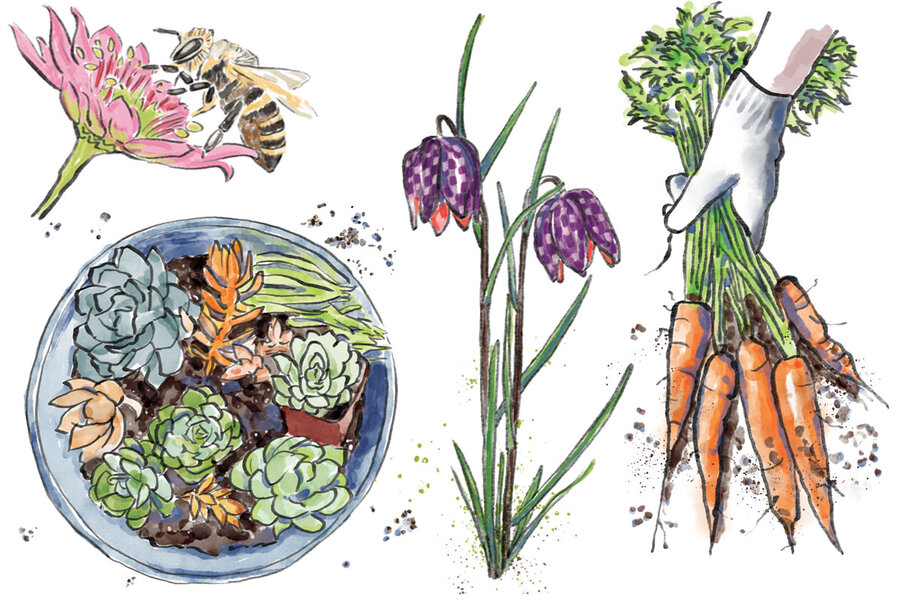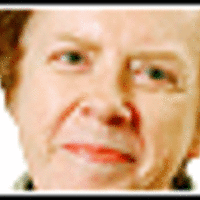Too early to plant? Grab a gardening book.
Loading...
Are the best garden vegetables – the juiciest tomatoes, the spiciest peppers, the crunchiest cucumbers – the result of what happens in the warmth of summer? Many gardeners believe that the most productive gardens have their roots in winter. That’s when they think about helpful advice they’ve gotten from gardening friends and neighbors, and from garden books they’ve read when it’s too chilly to be working outdoors.
No matter how long you’ve been gardening, there’s always much to learn from those who also like to dig in the soil. And this results in better gardens and easier gardening. For instance, did you know that honeybees don’t pollinate your tomatoes? A book explains that while honeybees (a European import) get all the press about vanishing pollinators, you need native bees to produce tasty tomatoes. And a longtime gardening expert tells how he learned about an inexpensive pantry item to get rid of weeds more ecologically and cheaply than noxious chemicals.
“Homegrown National Park”
When Douglas Tallamy wrote “Bringing Nature Home” in 2009, people were aware of the problem of increasingly disappearing wildlife. The book became a bestseller by pointing out what many people hadn’t realized: Native animals, birds, and insects were becoming extinct because they were starving for certain native plants that are a major part of their diets but were increasingly unavailable. Instead of planting native oaks, cities were now setting out callery pears along their streets. And due to construction, milkweeds and fall-blooming asters were no longer available in fields to sustain migrating monarch butterflies. Caterpillars that wild creatures depended on for food weren’t there when they needed them.
In “Nature’s Best Hope: A New Approach to Conservation That Starts in Your Yard,” Tallamy suggests a way that any homeowner can make a positive difference. He calls it Homegrown National Park, restoring habitat wherever we live and work, no matter how small our property may be.
Start by halving the size of your lawn, he recommends. Then think about planting native plants instead of Asian and European shrubs and trees. Keystone trees that he says are most helpful include oaks, cherries, willows, and cottonwoods. For plants, he recommends blueberries, goldenrods, asters, and sunflowers.
Any native plant will help – keeping in mind that you’ll want to have something blooming all three seasons – but those keystones will have the most impact. Tallamy explains his vision and answers questions from skeptics while showing that every person can help bring back beautiful monarch butterflies and other wild creatures. Ordinary people, he believes, are “nature’s best hope.”
Practical wisdom
Ciscoe Morris is a well-known gardening expert in the Pacific Northwest. Formerly head gardener at Seattle University, he likes to tell amusing tales of his gardening experiences. In “Oh, La La! Homegrown Stories, Helpful Tips, and Garden Wisdom” he entertains while he educates. While not all gardeners think of dandelions as weeds, when dandelions take over a landscape, often something must be done. Once while appearing as an expert gardener on a radio show, he was explaining his laborious method of digging out dandelions when a listener called to ask why he didn’t douse them with vinegar.
What a revelation! Plain old white vinegar, undiluted, applied generously on a hot (78 F or warmer) sunny day. Generous dollops kill almost any weeds. Vinegar also works well on weeds growing between cracks in sidewalks. It will also kill the surrounding grass, but there’s a solution for that, he says. Wait a few days after spraying to punch holes in the affected part of the lawn with a large screwdriver. Then drop grass seed into the holes, apply organic lawn food, and keep the area moist. In three weeks, grass will be growing.
When planting spring-flowering bulbs, most longtime gardeners know only one way to avoid squirrel damage: Plant bulbs that are poisonous to squirrels – daffodils, hyacinths, and fritillaries. But what if squirrels destroy your tulips, a favorite of theirs? Those who have well-drained soil (no clay) should plant tulips 12 inches deep, Morris says. That’s deeper than squirrels will usually dig.
The best pollinators
Paige Embry, author of “Native Bees: North America’s Endangered Pollinators and the Fight to Save Them,” prefers native mason bees over honeybees, which aren’t able to pollinate her favorite crop, tomatoes. While honeybees came from Europe with the colonists, there are 4,000 kinds of bees native to the United States and Canada.
She says that mason bees rarely sting, they’re superb pollinators, and they’re easy for novices to raise. They’re also available to work earlier in the season than honeybees are, since they pollinate when temperatures range about 54 F. Honeybees pollinate best when the temperature is above 65.
Armchair gardening
When it’s too hot or cold to go outside, it’s still fun to read about gardening. In “Everything for the Garden,” three noted historians and a curator for Historic New England share their knowledge and enthusiasm in a quartet of essays. These include a nostalgic look at garden catalogs from the 19th and 20th centuries and an exploration of early American gardens, many of which were inspired by photographs of estate gardens in Britain. In an essay about the social revolution and the rise of garden clubs in the United States (the first was started in Athens, Georgia, in 1891), the writer explains that women in Victorian times became members because they liked to read about gardening more than they actually wanted to get their hands dirty.
Small is beautiful
If you live near Santa Barbara, California, as garden designer Isa Eaton does, you’ll find a cornucopia of delightful gardens in “Small Garden Style: A Design Guide for Outdoor Rooms and Containers.” Year-round succulent gardens probably aren’t practical for those in colder parts of the country. But Eaton offers plenty of valuable style tips for those far from California.
When planning tabletop container gardens, she suggests choosing containers in unique shapes and finishes because they’ll be seen up close. For the best appearance, be sure to cover soil and edges of nursery containers with moss. Then make sure you can see over the top of the planter when seated. Also remember to give the plants adequate light, particularly indoors.
When you’re not sure about selecting plants that will look right in your small garden, Eaton makes these suggestions:
• Focus on leaves over blooms.
• Think long term, with perennials, and less about showy annuals.
• Stay with one or two colors.
• Limit the types of trees to two varieties.
• Choose plants that match the available light.
Vegetables in containers
Much of the growing advice in “Grow Fruit and Vegetables in Pots: Planting Advice & Recipes From Great Dixter” is geared toward British gardens and isn’t practical for those in the U.S. Still, it’s fascinating reading. And gardeners who are just getting started with containers can find valuable advice about the various sizes of pots to choose for different vegetables. (How much space does a mature eggplant need?)
Aaron Bertelsen is the vegetable gardener and cook at Great Dixter, a 15th-century house museum in East Sussex, England, and site of Christopher Lloyd’s famous gardens. Lloyd wrote books such as “The Well-Tempered Garden,” and he championed unusual plants and practical methods of growing them. The gardens featured at Great Dixter have become popular among garden tourists from around the world.
Half of the book is devoted to recipes. I loved lettuce soup, which I enjoyed because it uses ribs and outer leaves of lettuce, which I often toss away. And can you imagine making ice cream from fig leaves? Basil jelly sounds as if it will be a delightful summer project.








